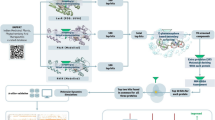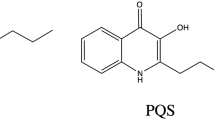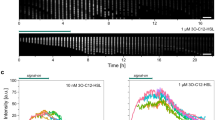Abstract
Quorum sensing (QS) is the regulation of gene expression in response to the concentration of small signal molecules, and its inactivation has been suggested to have great potential to attenuate microbial virulence. It is assumed that unlike antimicrobials, inhibition of QS should cause less Darwinian selection pressure for bacterial resistance. Using the opportunistic pathogen Pseudomonas aeruginosa, we demonstrate here that bacterial resistance arises rapidly to the best-characterized compound that inhibits QS (brominated furanone C-30) due to mutations that increase the efflux of C-30. Critically, the C-30-resistant mutant mexR was more pathogenic to Caenorhabditis elegans in the presence of C-30, and the same mutation arises in bacteria responsible for chronic cystic fibrosis infections. Therefore, bacteria may evolve resistance to many new pharmaceuticals thought impervious to resistance.
Similar content being viewed by others
Log in or create a free account to read this content
Gain free access to this article, as well as selected content from this journal and more on nature.com
or
Accession codes
References
Alverdy J, Holbrook C, Rocha F, Seiden L, Wu RL, Musch M et al. (2000). Gut-derived sepsis occurs when the right pathogen with the right virulence genes meets the right host – evidence for in vivo virulence expression in Pseudomonas aeruginosa. Ann Surg 232: 480–488.
Bjarnsholt T, Tolker-Nielsen T, Høiby N, Givskov M . (2010). Interference of Pseudomonas aeruginosa signalling and biofilm formation for infection control. Expert Rev in Mol Med 12: e11.
Brenner S . (1974). The genetics of Caenorhabditis elegans. Genetics 77: 71–94.
Chen H, Yi C, Zhang J, Zhang W, Ge Z, Yang CG et al. (2010). Structural insight into the oxidation-sensing mechanism of the antibiotic resistance of regulator MexR. EMBO Rep 11: 685–690.
Crane JK, Olson RA, Jones HM, Duffey ME . (2002). Release of ATP during host cell killing by enteropathogenic E. coli and its role as a secretory mediator. Am J Physiol Gastrointest Liver Physiol 283: G74–G86.
Defoirdt T, Boon N, Bossier P . (2010). Can bacteria evolve resistance to quorum sensing disruption? PLoS Pathog 6: e1000989.
Defoirdt T, Miyamoto CM, Wood TK, Meighen EA, Sorgeloos P, Verstraete W et al. (2007). The natural furanone (5Z)-4-bromo-5-(bromomethylene)-3-butyl-2(5H)-furanone disrupts quorum sensing-regulated gene expression in Vibrio harveyi by decreasing the DNA-binding activity of the transcriptional regulator protein LuxR. Environ Microbiol 9: 2486–2495.
Gram L, Nys Rd, Maximilien R, Givskov M, Steinberg P, Kjelleberg S . (1996). Inhibitory effects of secondary metabolites from the red alga Delisea pulchra on swarming motility of Proteus mirabilis. Appl Environ Microbiol 62: 4284–4287.
Harrison EM, Carter ME, Luck S, Ou HY, He X, Deng Z et al. (2010). Pathogenicity islands PAPI-1 and PAPI-2 contribute individually and synergistically to the virulence of Pseudomonas aeruginosa strain PA14. Infect Immun 78: 1437–1446.
Hegde M, Wood TK, Jayaraman A . (2009). The neuroendocrine hormone norepinephrine increases Pseudomonas aeruginosa PA14 virulence through the las quorum-sensing pathway. Appl Microbiol Biotechnol 84: 763–776.
Hentzer M, Wu H, Anderson JB, Riedel K, Rasmussen TB, Bagge N et al. (2003). Attenuation of Pseudomonas aeruginosa biofilm virulence by quorum sensing inhibitors. EMBO J 22: 3803–3815.
Heurlier K, Dénervaud V, Haenni M, Guy L, Krishnapillai V, Haas D . (2005). Quorum-sensing-negative (lasR) mutants of Pseudomonas aeruginosa avoid cell lysis and death. J Bacteriol 187: 4875–4883.
Jones MB, Jani R, Ren D, Wood TK, Blaser MJ . (2005). Inhibition of Bacillus anthracis growth and virulence gene expression by inhibitors of quorum-sensing. J Infect Dis 191: 1881–1888.
Kim C, Kim J, Park H-Y, Park H-J, Lee J, Kim C et al. (2008). Furanone derivatives as quorum-sensing antagonists of Pseudomonas aeruginosa. Appl Microbiol Biotechnol 80: 37–47.
Kimura Y, Turner JR, Braasch DA, Buddington RK . (2005). Lumenal adenosine and AMP rapidly increase glucose transport by intact small intestine. Am J Physiol Gastrointest Liver Physiol 289: G1007–G1014.
Koch B, Liljefors T, Persson T, Nielsen J, Kjelleberg S, Givskov M . (2005). The LuxR receptor: the sites of interaction with quorum-sensing signals and inhibitors. Microbiology 151: 3589–3602.
Kuchma SL, Brothers KM, Merritt JH, Liberati NT, Ausubel FM, O’Toole GA . (2007). BifA, a cyclic-Di-GMP phosphodiesterase, inversely regulates biofilm formation and swarming motility by Pseudomonas aeruginosa PA14. J Bacteriol 189: 8165–8178.
Lee J, Attila C, Cirillo SL, Cirillo JD, Wood TK . (2009). Indole and 7-hydoxyindole diminish Pseudomonas aeruginosa virulence. Microb Biotechnol 2: 75–90.
Liberati NT, Urbach JM, Miyata S, Lee DG, Drenkard E, Wu G et al. (2006). An ordered, nonredundant library of Pseudomonas aeruginosa strain PA14 transposon insertion mutants. Proc Natl Acad Sci 103: 2833–2838.
Macé C, Seyer D, Chemani C, Cosette P, Di-Martino P, Guery B et al. (2008). Identification of biofilm-associated cluster (bac) in Pseudomonas aeruginosa involved in biofilm formation and virulence. PLoS One 3: e3897.
Mahajan-Miklos S, Tan MW, Rahme LG, Ausubel FM . (1999). Molecular mechanisms of bacterial virulence elucidated using a Pseudomonas aeruginosa–Caenorhabditis elegans pathogenesis model. Cell 96: 47–56.
Oliver A, Mena A . (2010). Bacterial hypermutation in cystic fibrosis, not only for antibiotic resistance. Clin Microbiol Infect 16: 798–808.
Patel NJ, Zaborina O, Wu L, Wang Y, Wolfgeher DJ, Valuckaite V et al. (2007). Recognition of intestinal epithelial HIF-1α activation by Pseudomonas aeruginosa. Am J Physiol Gastrointest Liver Physiol 292: G134–G142.
Pearson JP, Van Delden C, Iglewski BH . (1999). Active efflux and diffusion are involved in transport of Pseudomonas aeruginosa cell-to-cell signals. J Bacteriol 181: 1203–1210.
Rasko DA, Sperandio V . (2010). Anti-virulence strategies to combat bacteria-mediated disease. Nat Rev Drug Discov 9: 117–128.
Ren D, Bedzyk LA, Thomas SM, Ye RW, Wood TK . (2004). Gene expression in Escherichia coli biofilms. Appl Microbiol Biotechnol 64: 515–524.
Ren D, Sims JJ, Wood TK . (2001). Inhibition of biofilm formation and swarming of Escherichia coli by (5Z)-4-bromo-5-(bromomethylene)-3-butyl-2-(5H)-furanone. Environ Microbiol 3: 731–736.
Ren D, Zuo R, Wood TK . (2005). Quorum-sensing antagonist (5Z)-4-bromo-5-(bromomethylene)-3-butyl-2(5H)-furanone influences siderophore biosynthesis in Pseudomonas putida and Pseudomonas aeruginosa. Appl Microbiol Biotechnol 66: 689–695.
Schuster M, Lostroh CP, Ogi T, Greenberg EP . (2003). Identification, timing, and signal specificity of Pseudomonas aeruginosa quorum-controlled genes: a transcriptome analysis. J Bacteriol 185: 2066–2079.
Shimizu K, Ogura H, Goto M, Asahara T, Nomoto K, Morotomi M et al. (2006). Altered gut flora and environment in patients with severe SIRS. J Trauma 60: 126–133.
Tomás M, Doumith M, Warner M, Turton JF, Beceiro A, Bou G et al. (2010). Efflux pumps, OprD porin, AmpC beta-lactamase, and multiresistance in Pseudomonas aeruginosa isolates from cystic fibrosis patients. Antimicrob Agents Chemother 54: 2219–2224.
Ueda A, Attila C, Whiteley M, Wood TK . (2009). Uracil influences quorum sensing and biofilm formation in Pseudomonas aeruginosa and fluorouracil is an antagonist. Microb Biotechnol 2: 62–74.
Ueda A, Wood TK . (2009). Connecting quorum sensing, c-di-GMP, Pel polysaccharide, and biofilm formation in Pseudomonas aeruginosa through tyrosine phosphatase TpbA (PA3885). PLoS Pathog 6: e1000483.
Wagner VE, Bushnell D, Passador L, Brooks AI, Iglewski BH . (2003). Microarray analysis of Pseudomonas aeruginosa quorum-sensing regulons: effects of growth phase and environment. J Bacteriol 185: 2080–2095.
Wiegand I, Hilpert K, Hancock REW . (2008). Agar and broth dilution methods to determine the minimal inhibitory concentration (MIC) of antimicrobial substances. Nat Protocols 3: 163–175.
Yang L, Rybtke MT, Jakobsen TH, Hentzer M, Bjarnsholt T, Givskov M et al. (2009). Computer-aided identification of recognized drugs as Pseudomonas aeruginosa quorum-sensing inhibitors. Antimicrob Agents Chemother 53: 2432–2443.
Zaborin A, Romanowski K, Gerdes S, Holbrook C, Lepine F, Long J et al. (2009). Red death in Caenorhabditis elegans caused by Pseudomonas aeruginosa PAO1. Proc Natl Acad Sci 106: 6327–6332.
Acknowledgements
This work was supported by the NIH (R01 GM089999). We thank Dr N Woodford and Dr D Livermore from the Centre for Infections, Health Protection Agency, United Kingdom, for their help with the clinical CF isolates. TM is grateful for the Excellent Young Researchers Overseas Visit Program Fellowship of the Japan Society for the Promotion of Science. RG-C was supported by the SEP/CONACyT grant 152794. TW is the T Michael O’Connor II Endowed Chair and Professor at the Texas A&M University.
Author information
Authors and Affiliations
Corresponding author
Rights and permissions
About this article
Cite this article
Maeda, T., García-Contreras, R., Pu, M. et al. Quorum quenching quandary: resistance to antivirulence compounds. ISME J 6, 493–501 (2012). https://doi.org/10.1038/ismej.2011.122
Received:
Revised:
Accepted:
Published:
Issue date:
DOI: https://doi.org/10.1038/ismej.2011.122
Keywords
This article is cited by
-
It is the time for quorum sensing inhibition as alternative strategy of antimicrobial therapy
Cell Communication and Signaling (2023)
-
In silico identification of new potential inhibitors of quorum sensing by Gram-positive bacteria through specialized molecular docking
Journal of Umm Al-Qura University for Applied Sciences (2023)
-
A clash of quorum sensing vs quorum sensing inhibitors: an overview and risk of resistance
Archives of Microbiology (2023)
-
Tackling recalcitrant Pseudomonas aeruginosa infections in critical illness via anti-virulence monotherapy
Nature Communications (2022)
-
Antimicrobial, radical scavenging, and dye degradation potential of nontoxic biogenic silver nanoparticles using Cassia fistula pods
Chemical Papers (2021)



